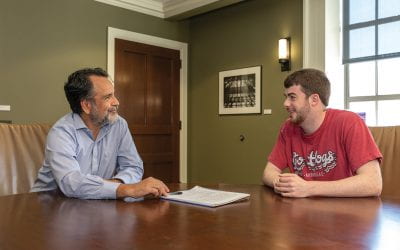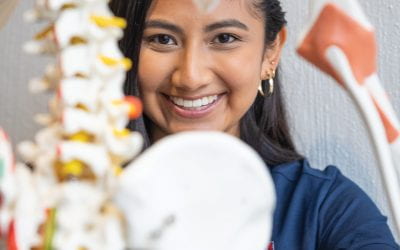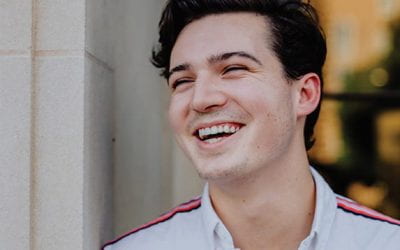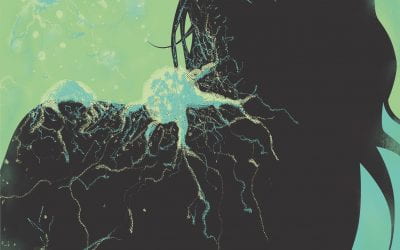Mary Jia searches for bacteria colonies that contain the plasmid needed to construct the gene-editing tool she’s designing
Prime Time for Gene Editing
By Katie Wilson Powell
Photos by Chieko Hara
Mary Jia, a biomedical engineering junior and Bodenhamer Fellow, has had her sights set on CRISPR editing since high school. Raised in Stuttgart, Arkansas, the rice capital of the world, she got started in research studying rice blast disease, a fungal disease with devastating impacts on her small Arkansas town and on the rice economy as a whole. While studying the genomes of one type of wild rice, Jia wanted to work with genetic elements that make this strand resistant to rice blast disease.

“I wanted to work on prime editing because I thought it would be super applicable in the clinical sphere.”

Jia and Chris Nelson examine the gel image of an isolated, ligated DNA, to be used for gene editing
Research on rice whetted Mary Jia’s appetite to focus on the possibilities of gene editing. After working briefly in a fish/agricultural lab, she knew she was ready for the big leagues — human cells. When a significant paper came out on the possibilities of CRISPR technology Jia, then a high school student, contacted Christopher Nelson, assistant professor of biomedical engineering and an Honors College alumnus (B.S.B.E., magna cum laude, ’09). She met him during an A-Week “Taste of Honors” seminar and began working in his lab her freshman year.
“In the broad sphere, I work on developing gene editing solutions to rare genetic diseases,” said Jia. She is currently focusing on Duchenne muscular dystrophy, which is caused by a genetic mutation that prevents the body from producing functional dystrophin, a protein that all muscles need to work properly. As scientists have worked to find a cure for this rare genetic disease, many have attempted to edit the gene that causes this mutation through removal, splicing, and editing. Jia’s solution, building on the solutions of others, is that of prime editing.
“My specific strategy essentially skips exons, the sequences in our body that are later used to produce protein,” said Jia. Skipping an exon can restore the order of a DNA sequence and produce a truncated protein that allows the muscles to operate. This process is less dangerous than previous treatment options in that the edit being incorporated into the DNA is relatively minor compared to strategies that excise the entire exon. “Essentially, it’s a much more refined version of gene editing,” said Jia. “I wanted to work on prime editing because I thought it would be super applicable in the clinical sphere.”
As the first undergraduate student in Nelson’s lab, Jia is working to refine prime editing solutions with the help of CRISPR-Cas9, a combination of a protein and a guide RNA that was first developed by Jennifer Doudna, a Nobel prize winner at Berkeley, and refined at the Broad Institute. Working with CRISPR-Cas9 (and any experiments, for that matter), has been bittersweet according to Jia. “You always want your experiment to work the first time,” she said, “but that’s not how science works.”

Jia runs a gel electrophoresis experiment that separates DNA based on size and charge.
Like many other researchers, Jia was barred from working in the lab during the COVID-19 lockdown. Instead of admitting defeat, however, she used that time to virtually meet many of her heroes in the field by participating in virtual conferences. Additionally, she conducted a computational analysis project analyzing the known cases of Duchenne muscular dystrophy in her spare time. “When you start out, you realize that all scientists know nothing. You continually realize how much you don’t know, which only furthers the drive to understand,” said Jia with her characteristic enthusiasm.
Nelson, Jia’s advisor, attests that “Since I first met Mary, I have been consistently impressed with her curiosity about medicine and her drive to apply cutting-edge technologies to treat patients. She has been exceptionally resilient against setbacks in 2020 and is already becoming a pioneer establishing new methods in our lab.”
Though Jia is working right now on muscular dystrophy, she hopes to apply her research to other critical diseases — she’s coming for cancer. “All of us have known a lot of people who have had cancer, and it’s only increasing,” said Jia. “I plan to apply gene editing techniques to cancer due to the primarily genetic nature of cancerous cells.”
Jia still has a few years of her undergraduate career left, but understands the importance, and the value, of trying and then trying again. “Determination is key. Perseverance is key. You have to read a lot, and contrary to my own patterns, make sure you sleep.”
She also attests to the importance of staying true to your path, of taking great risks even at the prospect of failure. “I think a lot of students come into lab scared of disappointing mentors and peers, but you have to realize that we are all failing at science and succeeding at 1%. The 1% is what you publish.”
Jia’s research was supported by a SURF grant.
More Field Notes
Goodwill Job Hunting
By Katie Wilson PowellPhotos by Chieko Hara For Jimmy Donlon, a senior marketing and management major and Honors College fellow, serving the community has meant being a part of the community throughout his entire life. Donlon’s father, a physician, founded a network...
Love Your Back? Take a Break!
By Hiba TahirPhotos by Russell Cothren Sitting down may be hazardous to your health. Those who spend several hours a day in seated positions — which, in the last year or two, is most of us, thanks to the COVID-19 pandemic — may find themselves struggling with lower...
Power Plays
By Kendall CurleePhotos by Beau Burris“The grand scale of both Versailles and D.C., built to awe and impress, gets the job done.”Washington, D.C. Satellite imagery © Google Earth Versailles, France. Satellite imagery © Google Earth Beau Burris has been obsessed with...
The Monster She Made
Image: Leigh Caruthers PrasselBy Hiba TahirPhotos by Chieko HaraWhen a family member was diagnosed with Ewing’s sarcoma, a rare form of bone cancer, Morgan Walker, an English major from Prairie Grove, saw many similarities between the grim prognosis and the plight of...
Conscious Couture
By Hiba TahirPhotos by Hiba Tahir and Chieko Hara With normalcy beginning to return after months spent working from home, mostly in sweatpants, many are itching to refresh their wardrobes. Before you whip out your card for the latest trends, though, consider this:...






